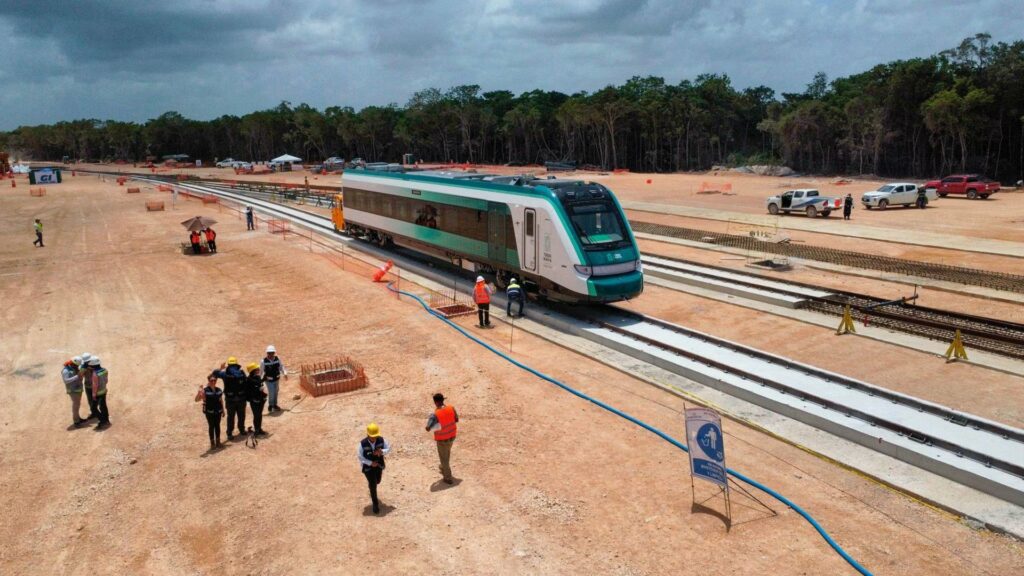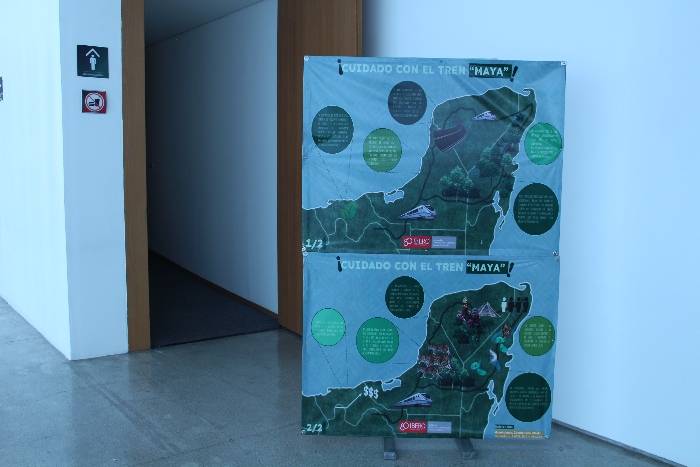Text and photos by: Yazmin Mendoza

The mega-project under construction in the Yucatan Peninsula, the “misnamed Mayan Train, because it has nothing Mayan about it,” as the communities of the region in resistance call it, is far from detonating the progress that is truly needed. On the contrary, it exacerbates problems of dispossession, deforestation, access to water, contamination, discrimination, division, poverty and even organized crime, agreed representatives of these communities, as well as researchers and a researcher who participated in the elaboration of volume 1 of the book: Mayan Territories in the Passage of the Train. Foreseeable risks and independent positions on the Mayan Train.
They also pointed out that the tourist part -which is expected to be massive and destructive, as well as costly- is actually secondary, since what is really being pursued is the promotion of connectivity for cargo transportation and commercial exchange, especially in the face of the drought that has affected the flow through the Panama Canal. This was stated in the conversation The train is going… And where are We going? during the Mayan Train Week at IBERO on August 28-31, a space for reflection organized by the Observatory of Socio-environmental Conflicts (OCSA), the Transdisciplinary University Center for Sustainability (Centrus) and the Interculturality and Indigenous Affairs Programs (PIAI), University for Sustainability and Migratory Affairs (PRAMI).
The Mayan Train turns culture into a commercial tourism product
With this project of the federal government that crosses the states of Tabasco, Chiapas, Campeche, Yucatan and Quintana Roo, “our culture is presented as valuable as long as it is a tourist product. It is no longer necessary to go to a theme park to see our culture return to a spectacle, but rather the people of the community are beginning to have these same ways of looking at our culture,” lamented Wilma Esquivel Pat, a Mayan Macehual biologist and territorial community feminist from Felipe Carrillo Puerto in Quintana Roo.
She added that mass tourism is totally destructive, destructive and predatory. “Who are we as a people in this tourism, in a city that is not for us? We are the servants. In addition to the sale and expropriation of land, young people are also being displaced, he said, because in cities like Tulum or Bacalar – with the kind of development that the communities in resistance do not want – it is very difficult for a young woman or man to pay rent.

Deforestation for the Mayan Train affects Biosphere Reserves
Environmentally, there is tremendous deforestation, the Calakmul Biosphere Reserve is being destroyed, said Sara López González, a Mayan woman born in Candelaria, Campeche, who is a defender of indigenous peoples, the countryside and life. “When we walk and travel to that part, it hurts our soul, it hurts our heart, because we see all the deforestation where the tracks are going to run.”
Dr. Alba Margarita Campos Buendía, researcher at the Latin American Faculty of Social Sciences in Mexico (FLACSO) and author of one of the chapters of the book “Mayan Territories in the Passage of the Train”, pointed out that in the South-Southeast Peninsula there are 49 archaeological zones, 15 federal and 20 state Natural Protected Areas, 24 wetlands, 24 conservation areas and one municipal ecological reserve – the Cuxtal reserve – which supplies 50% of the water to Mérida, Yucatán. “It is the geographic area where we have the most subterranean aquifers, there is the largest amount of available subterranean water on the planet.”
He added that in 2015 tourism activity was the productive process that brought the greatest environmental deterioration to the Peninsula, and for 2019, this deterioration is mostly related to the development of hotel and infrastructure project, including the Tren Maya (Mayan Train).
The real objective is connectivity for regional trade.
Dr. Campos Buendía, like the rest of the participants in the talk, pointed out that the Tren Maya is more than the tracks: it is a gateway to regional and global trade and integration. ” Above all, the State is interested in opening the gateway to these capitals through the Train, especially in terms of commercial exchange. The tourist part is the plus”.
Eduardo Martínez Romero, Master in Ecology and Environmental Sciences at UNAM, pointed out the problem of the drought affecting Panama Canal in Central America, which has reduced the flow of goods and services, “all maritime transportation is turning to the Yucatan Peninsula and the Isthmus of Tehuantepec”.
Hence the importance for the government to build these communication circuits, with the Transisthmian Train and the train circuit in the Yucatan Peninsula, Tabasco and Chiapas, said the author of one of the chapters of the book.
The idea of connectivity in the South-Southeast is nothing new.
Dr. Miguel Angel Diaz Perera, researcher at the Colegio de la Frontera Sur, considered that the Tren Maya is a very conventional development project that has nothing new about it. He mentioned a whole series of similar projects that were carried out during the last century, such as the one that was later called Ferrocarril del Sureste, during the late 19th and early 20th centuries.
This was actually an integrating project between the Ferrocarril Nacional de Tehuantepec and Ferrocarriles Unidos Yucatán. The academic pointed out that in the last century the idea of connecting the Tehuantepec National Railroad and turning it around the Yucatan Peninsula, like a horseshoe, persisted. In fact, the Southeastern Railroad project was a presidential flag of President Lázaro Cárdenas.
Even when the present project retakes the use of sections of old tracks, Dr. Diaz Perera emphasized that in this and in all the previous projects, narratives that seek to break with the past were used, as if nothing had existed before them, and “the idea of the narrative of overcoming the backwardness, the idea of the narrative of hope, has been constant”.

Communities want to be taken into account
“Since they invaded us, the native peoples have been kept under tutelage, they have thought that we do not have the capacity to decide about our lives,” denounced Esquivel Pat, also a poet and Vice President of the U kúuchil K Ch’i’ibalo’on Community Center. She lamented that it has been thought that the knowledge of the peoples has no value. “I am trained as a biologist, but, in all honesty, I find the reason for life and fulfillment in the wisdom of my people”.
For her part, Sara López emphasized: “We say no to the Mayan Train, not because we do not want development, not because we do not want the progress of the community, but because this is not the progress of the community”. What they really want, she said, is to live their own autonomy, “with our practices, with our ways, with our customs, with our way of being, and these have been taken away from us”.
If you are interested in supporting these communities in resistance, the activist recommends following the information disseminated by the National Indigenous Congress (CNI), the Resistance Network and the Mexican Center for Environmental Law (CEMDA) – regarding the legal appeals that the inhabitants have filed against the dispossessions – and making more visible these actions in defense of the territory, “so that the whole world knows what we are living through”.
As part of the Maya Train Week, there was also the immersive experience “Rails and Roots: the socio-environmental impacts of the construction of the Maya Train”, and the workshop “Trajectories and Transformations: geographic visualization of the passage of the Maya Train”.
Original Text: https://desinformemonos.org/por-que-las-comunidades-no-quieren-el-mal-llamado-tren-maya/
